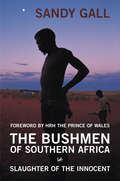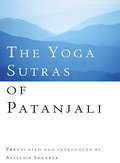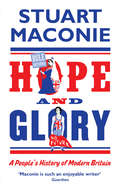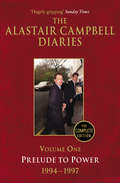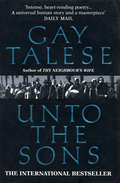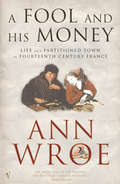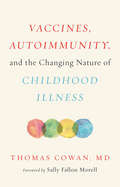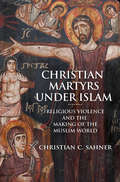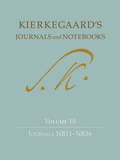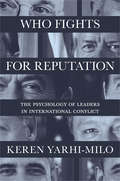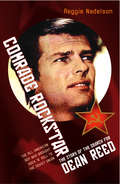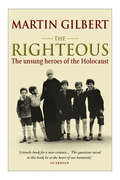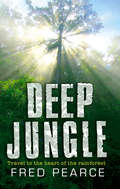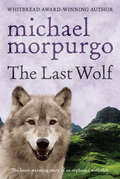- Table View
- List View
Magnum: Fifty Years at the Front Line of History
by Russell MillerThis book is a biography of Magnum, told largely in the words of its photographers. It offers a unique perspective on half a century of world history from an extraordinary group of men and women who were front line witnesses at virtually every major event in the last fifty years. Wars, famines, natural disasters, social, political and environmental crises - Magnum photographers were there. They have been acute observers of the human condition, photographing the richest people in the world, the poorest, the least known and the most celebrated, from Marilyn Monroe to Che Guevara, JFK to Nelson Mandela, Picasso to Krushchev. This is a multi-layered story. At one level, it tells how a small group of photographrs - among them Robert Capa, Henri Cartier-Bresson and George Rodger - came together, established and nurtured a co-operative photographic agency that has survived against all the odds to become the most famous in the world. At a secondary level, it is the richly anecdotal story of the photographers themselves, their adventures around the world and their feelings about, and reactions to, their assignments.
The Bushmen Of Southern Africa: Slaughter Of The Innocent
by Sandy GallBushmen were hunting and gathering, painting and mining copper, thousands of years ago. They were the first people of Africa. Deadly shots with their bows and arrows, they were, in their heyday, Lords of the Desert. They fought extremely bravely for their land, and lost. Today, they have been reduced to an underclass - dispossessed, despised and degraded. Just in time - one is tempted to say, miraculously - the Mandela government saved them from extermination in South Africa. Now, in Botswana's Central Kalahari Game Reserve, set aside specially for them by the British in 1961, they are making their last stand, refusing to be evicted in order to benefit mining and tourism. Sandy Gall, who is best known for his reporting of the Soviet occupation of Afghanistan, has taken up the cause of the Bushmen. His interest in their plight dates back to the 1950s and 1960s when he was working as a foreign correspondent for Reuters; in 1999 he visited the Central Kalahari with his daughter Michaela. His book celebrates the culture of these unique people, many of whom have an almost mystical bond with animals. He has portrayed many fascinating individuals who have been involved, for good or ill, in their tragic history and their present predicament. Here, for the first time, is the full story of the slaughter of an innocent people. The Bushmen of Southern Africa speaks not only for the Bushmen but for the native indigenous people of the world. It faces up to a shameful and bloodstained past and looks at burning current issues such as human rights and the ownership and exploitation of land.
The Middle Sea: A History of the Mediterranean
by Viscount John NorwichAn electrifying narrative history of the Mediterranean from Ancient Egypt to 1919, from the bestselling author of The Popes and Sicily: A Short HistoryThe Mediterranean has nurtured three of the most dazzling civilisations of antiquity, witnessed the growth of three of our greatest religions and links three of the world's six continents. John Julius Norwich has visited every country around its shores; now he tells the story of the Middle Sea - a tale that begins with the Pharaohs and ends with the Treaty of Versailles - in a dramatic account of the remarkable civilisations that rose and fell on the lands of the Mediterranean.Expertly researched and ingeniously executed, Norwich takes us through the Arab conquests of Syria and North Africa; the Holy Roman Empire and the Crusades; Ferdinand and Isabella and the Spanish Inquisition; the great sieges of Rhodes and Malta by the Sultan Süleyman the Magnificent; the pirates of the Barbary Coast and the Battle of Lepanto; Nelson and Napoleon; the Greek War of Independence and the Italian Risorgimento.The Middle Sea is colourful, character-driven history at its most enjoyable and is the culmination of John Julius Norwich’s distinguished career as one of the greatest enthusiasts for anecdotal history.‘An expertly paced, exhilarating read….a landmark in popular history-telling...a splendid achievement for its memorable scope and vitality... This wonderfully riveting history reveals our favourite holiday destination in all its glorious, epic depth’ Sunday Telegraph
Pimlico History Of 20th Century
by Clive PontingHow has the world changed in the last century? As we look back across a hundred years of turbulence, Clive Ponting provides a major reassessment of what the twentieth century hgas meant to people throughout the world. THE PIMLICO HISTORY OF THE TWENTIETH CENTURY analyses the fundamental forces of population, industry and their consequences for the environment. it traces the rise and full of empires, the impact of nationalism, examines domestic politics from all political persepctives, and considers the darker side of history in the growing repressive power of states across the world and the most terrible of twentieth-century crimes - genocide. THE PIMLICO HISTORY OF THE TWENTIETH CENTURY is a provocative and challenging analysis of the whole world in the twentieth century, combining a global sweep with an eye for detail and individual experiences.
The Yoga Sutras Of Patanjali (Sacred Teachings Ser.)
by Alistair ShearerThe basic questions of Who Am I? Where Am I Going? What Is the Purpose of Life? are asked by every generation, and Patanjali's answers (given in the third century BC) form one of the oldest spiritual texts in the world. 'That which unites' is called 'Yoga' - and is thus much broader than the form of exercise so popular today. It is a way to restore our lost wholeness, our integrity as complete human beings, by unifying the personality around a centre that is silent and unbounded. Alistair Shearer's superb introduction and translation bring these ancient, vital teachings to life in the modern world and are for all those who seek the benefits of self-knowledge.
Performing Remembering: Women's Memories of War in Vietnam (Contemporary Performance InterActions)
by Rivka Syd EisnerThis book explores the performances and politics of memory among a group of women war veterans in Ho Chi Minh City, Vietnam. Through ethnographic, oral history-based research, it connects the veterans’ wartime histories, memory politics, performance practices, recollections of imprisonment and torture, and social activism with broader questions of how to understand and attend to continuing transgenerational violence and trauma. With an extensive introduction and subsequent chapters devoted to in-depth analysis of four women’s remarkable life stories, the book explores the performance and performativity of culture; ethnographic oral history practice; personal, collective, and (trans)cultural memory; and the politics of postwar trauma, witnessing, and redress. Through the veterans’ dynamic practices of prospective remembering, 'pain-taking', and enduring optimism, it offers new insights into matrices of performance vital to the shared work of social transformation. It will appeal to readers interested in performance studies, memory studies, gender studies, Vietnamese studies, and oral history.
Performing Remembering: Women's Memories of War in Vietnam (Contemporary Performance InterActions)
by Rivka Syd EisnerThis book explores the performances and politics of memory among a group of women war veterans in Ho Chi Minh City, Vietnam. Through ethnographic, oral history-based research, it connects the veterans’ wartime histories, memory politics, performance practices, recollections of imprisonment and torture, and social activism with broader questions of how to understand and attend to continuing transgenerational violence and trauma. With an extensive introduction and subsequent chapters devoted to in-depth analysis of four women’s remarkable life stories, the book explores the performance and performativity of culture; ethnographic oral history practice; personal, collective, and (trans)cultural memory; and the politics of postwar trauma, witnessing, and redress. Through the veterans’ dynamic practices of prospective remembering, 'pain-taking', and enduring optimism, it offers new insights into matrices of performance vital to the shared work of social transformation. It will appeal to readers interested in performance studies, memory studies, gender studies, Vietnamese studies, and oral history.
Hope and Glory: A People’s History of Modern Britain
by Stuart MaconieIn Hope and Glory Stuart Maconie goes in search of the days that shaped the Britain we live in today. Taking one event from each decade of the 20th century, he visits the places where history happened and still echoes down the years. Stuart goes to Orgreave and Windsor, Wembley and Wootton Bassett, assembling a unique cast of Britons from Sir Edmund Hillary to Sid Vicious along the way.It’s quite a trip, full of sex and violence and the occasional scone and jigsaw. From pop stars to politicians, Suffragettes to punks, this is a journey around Britain in search of who we are.
Diaries Volume One: Prelude to Power (The Alastair Campbell Diaries)
by Alastair CampbellAs Alastair Campbell said in the introduction to The Blair Years, it was always his intention to publish the full version, covering his time as spokesman and chief strategist to Tony Blair. Prelude to Power is the first of four volumes, and covers the early days of New Labour, culminating in their victory at the polls in 1997.Volume 1 details the extraordinary tensions between Tony Blair and Gordon Brown as they resolved the question as to which one should stand to become Labour leader. It shows that right from the start, relations at the top were prone to enormous strain, suspicions and accusations of betrayal. Yet it also shows the political and personal bonds that tied them together, and which made them one of the most feared and respected electoral machines anywhere in the world. A story of politics in the raw, Prelude to Power is above all an intimate, detailed portrait of the people who have done so much to shape modern history.
Unto The Sons
by Gay TaleseUNTO THE SONS is Gay Talese's stirring epic of his family's exodus from a tiny village in southern Italy, caught up in the tide of young men who crossed the Atlantic to America at the end of the 19th century.
A Fool And His Money: Life in a Partitioned Medieval Town
by Ann WroeFew books have captured the atmosphere of daily medieval life as well or as movingly as A Fool and His Money. Rodez, in southern France, was divided for centuries by a feud between two masters. This partitioned town thus acquired two distinct cultures. The story focuses on the strange case of Peyre Marques, a merchant who forgets where he has buried his gold. To read A Fool and His Money is like opening a shutter on to a sunlit medieval street teeming with characters, talk and noise - all coloured with the vibrancy of truth. --'Wroe is an excellent historian and an engaging writer with a beady eye for detail and an attractive turn of phrase. Best of all, she conveys a true feeling for the recreation of period and persons and place' Daily Telegraph --'History lives best when it is loved, and nobody who reads this book can doubt the author's love of her subject' Sunday Telegraph
Vaccines, Autoimmunity, and the Changing Nature of Childhood Illness
by Dr Thomas Cowan Sally Fallon MorellOne Doctor’s Surprising Answer to the Epidemic of Autoimmunity and Chronic Disease Over the past fifty years, rates of autoimmunity and chronic disease have exploded: currently 1 in 2.5 American children has an allergy, 1 in 11 has asthma, 1 in 13 has severe food allergies, and 1 in 36 has autism. While some attribute this rise to increased awareness and diagnosis, Thomas Cowan, MD, argues for a direct causal relationship to a corresponding increase in the number of vaccines American children typically receive—approximately 70 vaccine doses by age eighteen. The goal of these vaccines is precisely what we’re now seeing in such abundance among our chronically ill children: the provocation of immune response. Dr. Cowan looks at emerging evidence that certain childhood illnesses are actually protective of disease later in life; examines the role of fever, the gut, and cellular fluid in immune health; argues that vaccination is an ineffective (and harmful) attempt to shortcut a complex immune response; and asserts that the medical establishment has engaged in an authoritarian argument that robs parents of informed consent. His ultimate question, from the point of view of a doctor who has decades of experience treating countless children is: What are we really doing to children when we vaccinate them?
Christian Martyrs under Islam: Religious Violence and the Making of the Muslim World
by Christian C. SahnerHow did the medieval Middle East transform from a majority-Christian world to a majority-Muslim world, and what role did violence play in this process? Christian Martyrs under Islam explains how Christians across the early Islamic caliphate slowly converted to the faith of the Arab conquerors and how small groups of individuals rejected this faith through dramatic acts of resistance, including apostasy and blasphemy.Using previously untapped sources in a range of Middle Eastern languages, Christian Sahner introduces an unknown group of martyrs who were executed at the hands of Muslim officials between the seventh and ninth centuries CE. Found in places as diverse as Syria, Spain, Egypt, and Armenia, they include an alleged descendant of Muhammad who converted to Christianity, high-ranking Christian secretaries of the Muslim state who viciously insulted the Prophet, and the children of mixed marriages between Muslims and Christians. Sahner argues that Christians never experienced systematic persecution under the early caliphs, and indeed, they remained the largest portion of the population in the greater Middle East for centuries after the Arab conquest. Still, episodes of ferocious violence contributed to the spread of Islam within Christian societies, and memories of this bloodshed played a key role in shaping Christian identity in the new Islamic empire. Christian Martyrs under Islam examines how violence against Christians ended the age of porous religious boundaries and laid the foundations for more antagonistic Muslim-Christian relations in the centuries to come.
Christian Martyrs under Islam: Religious Violence and the Making of the Muslim World
by Christian C. SahnerHow did the medieval Middle East transform from a majority-Christian world to a majority-Muslim world, and what role did violence play in this process? Christian Martyrs under Islam explains how Christians across the early Islamic caliphate slowly converted to the faith of the Arab conquerors and how small groups of individuals rejected this faith through dramatic acts of resistance, including apostasy and blasphemy.Using previously untapped sources in a range of Middle Eastern languages, Christian Sahner introduces an unknown group of martyrs who were executed at the hands of Muslim officials between the seventh and ninth centuries CE. Found in places as diverse as Syria, Spain, Egypt, and Armenia, they include an alleged descendant of Muhammad who converted to Christianity, high-ranking Christian secretaries of the Muslim state who viciously insulted the Prophet, and the children of mixed marriages between Muslims and Christians. Sahner argues that Christians never experienced systematic persecution under the early caliphs, and indeed, they remained the largest portion of the population in the greater Middle East for centuries after the Arab conquest. Still, episodes of ferocious violence contributed to the spread of Islam within Christian societies, and memories of this bloodshed played a key role in shaping Christian identity in the new Islamic empire. Christian Martyrs under Islam examines how violence against Christians ended the age of porous religious boundaries and laid the foundations for more antagonistic Muslim-Christian relations in the centuries to come.
Kierkegaard's Journals and Notebooks: Volume 10, Journals NB31-NB36 (Kierkegaard's Journals and Notebooks)
by Søren KierkegaardFor over a century, the Danish thinker Søren Kierkegaard (1813–55) has been at the center of a number of important discussions, concerning not only philosophy and theology, but also, more recently, fields such as social thought, psychology, and contemporary aesthetics, especially literary theory.Despite his relatively short life, Kierkegaard was an extraordinarily prolific writer, as attested to by the 26-volume Princeton University Press edition of all of his published writings. But Kierkegaard left behind nearly as much unpublished writing, most of which consists of what are called his “journals and notebooks.” Kierkegaard has long been recognized as one of history’s great journal keepers, but only rather small portions of his journals and notebooks are what we usually understand by the term “diaries.” By far the greater part of Kierkegaard’s journals and notebooks consists of reflections on a myriad of subjects—philosophical, religious, political, personal. Studying his journals and notebooks takes us into his workshop, where we can see his entire universe of thought. We can witness the genesis of his published works, to be sure—but we can also see whole galaxies of concepts, new insights, and fragments, large and small, of partially (or almost entirely) completed but unpublished works. Kierkegaard’s Journals and Notebooks enables us to see the thinker in dialogue with his times and with himself.Kierkegaard wrote his journals in a two-column format, one for his initial entries and the second for the extensive marginal comments that he added later. This edition of the journals reproduces this format, includes several photographs of original manuscript pages, and contains extensive scholarly commentary on the various entries and on the history of the manuscripts being reproduced.Volume 10 of this series includes the final six of Kierkegaard’s important “NB” journals (Journals NB31 through NB36), which cover the last months of 1854, a period when Kierkegaard made the final preparations for and the initial launch of his furious assault on the established church. But in addition to this incendiary material, these journals also contain a great trove of his reflections on theology, philosophy, and the perils and opportunities of modernity.
Who Fights for Reputation: The Psychology of Leaders in International Conflict (Princeton Studies in International History and Politics #156)
by Keren Yarhi-MiloHow psychology explains why a leader is willing to use military force to protect or salvage reputationIn Who Fights for Reputation, Keren Yarhi-Milo provides an original framework, based on insights from psychology, to explain why some political leaders are more willing to use military force to defend their reputation than others. Rather than focusing on a leader's background, beliefs, bargaining skills, or biases, Yarhi-Milo draws a systematic link between a trait called self-monitoring and foreign policy behavior. She examines self-monitoring among national leaders and advisers and shows that while high self-monitors modify their behavior strategically to cultivate image-enhancing status, low self-monitors are less likely to change their behavior in response to reputation concerns.Exploring self-monitoring through case studies of foreign policy crises during the terms of U.S. presidents Carter, Reagan, and Clinton, Yarhi-Milo disproves the notion that hawks are always more likely than doves to fight for reputation. Instead, Yarhi-Milo demonstrates that a decision maker's propensity for impression management is directly associated with the use of force to restore a reputation for resolve on the international stage.Who Fights for Reputation offers a brand-new understanding of the pivotal influence that psychological factors have on political leadership, military engagement, and the protection of public prestige.
Who Fights for Reputation: The Psychology of Leaders in International Conflict (Princeton Studies in International History and Politics #156)
by Keren Yarhi-MiloHow psychology explains why a leader is willing to use military force to protect or salvage reputationIn Who Fights for Reputation, Keren Yarhi-Milo provides an original framework, based on insights from psychology, to explain why some political leaders are more willing to use military force to defend their reputation than others. Rather than focusing on a leader's background, beliefs, bargaining skills, or biases, Yarhi-Milo draws a systematic link between a trait called self-monitoring and foreign policy behavior. She examines self-monitoring among national leaders and advisers and shows that while high self-monitors modify their behavior strategically to cultivate image-enhancing status, low self-monitors are less likely to change their behavior in response to reputation concerns.Exploring self-monitoring through case studies of foreign policy crises during the terms of U.S. presidents Carter, Reagan, and Clinton, Yarhi-Milo disproves the notion that hawks are always more likely than doves to fight for reputation. Instead, Yarhi-Milo demonstrates that a decision maker's propensity for impression management is directly associated with the use of force to restore a reputation for resolve on the international stage.Who Fights for Reputation offers a brand-new understanding of the pivotal influence that psychological factors have on political leadership, military engagement, and the protection of public prestige.
Comrade Rockstar
by Reggie NadelsonDean Reed was an American and the biggest rock star in the history of the Soviet Union. He was so famous his icons were sold alongside those of Josef Stalin. Reggie Nadelson first saw him in 1986 on a TV chat show. Few people in the West had ever heard of him. Six weeks later Reed was found dead in a lake in East Berlin. Was he murdered by the CIA? The KGB? A jealous husband? Nobody knew. Commissioned to write a film about him, she chased the mystery of his life and death across America and Eastern Europe, her own journey mirroring his. For a quarter of a century, from 1961 to 1986, Dean Reed, his guitar on his back, took the music with him. He played 32 countries: his albums went gold from Bulgaria to Berlin. The Russians gave him a Lenin Prize. He was their American. Comrade Rockstar is not just the story of Dean Reed's progress from Hollywood starlet to Cold War Cowboy, but an account of the search that took Reggie Nadelson from Denver to Berlin, and from Hawaii to Moscow. As she travelled, the Berlin Wall was breached and Dean Reed became an increasingly alluring figure, his life an unrepeatable tale from the Cold War. Encountering the characters who peopled Dean Reed's world, she was caught in the seedy, sometimes moving, often hilarious subculture, of sex, politics and rock 'n' roll.
The Righteous: The Unsung Heroes Of The Holocaust
by Dr Martin Gilbert'He who saves one life, it is as if he saved an entire world'The Holocaust will be forever numbered amongst the darkest of days in human civilisation. Yet even in that darkness, there were sparks of light. Many will recognise the names of Oskar Schindler, Raoul Wallenberg and Miep Gies. But there were thousands of others throughout Europe who risked their own lives to save Jews from the Nazis and their horrific campaign of obliteration that was the Holocaust. By the beginning of 2002, more than 19,000 non-Jews had been recognized as Righteous (Among the Nations) by Yad Vashem, the Holocaust museum in Jerusalem. Some were officials, some were clergy; others were citizens of countries who united in their efforts to protect Jews. Many were merely individuals who had the courage to stand up against a growing tide of collaboration and simply say: 'We did what we had to do'.Martin Gilbert, the foremost British historian of the Holocaust, here presents the evidence collected over many years. Cumulatively, these accounts, from every occupied country in Europe, from the Baltic to the Mediterranean, from the Atlantic to the Black Sea, and from inside the Third Reich itself, form an inspiring tribute to those heroic individuals who, without thought to the risk to their own lives, dared to challenge barbarism, and hold out the hand of rescue to the Jews of Europe.
Deep Jungle: Journey To The Heart Of The Rainforest
by Fred PearceDEEP JUNGLE is an exploration of the most alien and feared habitat on Earth. Starting with man's earliest recorded adventures, Fred Pearce journeys high into the canopy - home to two-thirds of all the creatures on our planet, many of whom never come down to earth. During his travels he encounters all manner of fantastic flora and fauna, including a frog that can glide from tree to tree, a spider that can drag live chickens into its burrow and a flower that smells of decaying flesh.It is in the jungle that Pearce discovers secrets about how evolution works, the intricate links that connect us all, and maybe even clues to where humans came from - here is the key to our future foods and medicines, our climate and our understanding of how life works. At the start of a new millennium Pearce asks why we continue to waste precious time - and billions of dollars - looking for signs of life elsewhere in our universe when the greatest range of life-forms that have ever existed lies right here on our doorstep. Today environmentalists say we are on the verge of destroying the last rainforests, and with them the planet's evolutionary crucible, and maybe even its ability to maintain life on Earth. But nature has a way of getting its own back. The Mayans and the people of Angkor went too far in manipulating nature and paid the ultimate price. Their civilisations died and the jungle returned. Nature reclaimed it's own and it may do so again ...
Too Important for the Generals: Losing and Winning the First World War
by Allan Mallinson‘War is too important to be left to the generals’ snapped future French prime minister Georges Clemenceau on learning of yet another bloody and futile offensive on the Western Front. One of the great questions in the ongoing discussions and debate about the First World War is why did winning take so long and exact so appalling a human cost? After all this was a fight that, we were told, would be over by Christmas. Now, in his major new history, Allan Mallinson, former professional soldier and author of the acclaimed 1914: Fight the Good Fight, provides answers that are disturbing as well as controversial, and have a contemporary resonance. He disputes the growing consensus among historians that British generals were not to blame for the losses and setbacks in the ‘war to end all wars’ – that, given the magnitude of their task, they did as well anyone could have. He takes issue with the popular view that the ‘amateur’ opinions on strategy of politicians such as Lloyd George and, especially, Winston Churchill, prolonged the war and increased the death toll. On the contrary, he argues, even before the war began Churchill had a far more realistic, intelligent and humane grasp of strategy than any of the admirals or generals, while very few senior officers – including Sir Douglas Haig – were up to the intellectual challenge of waging war on this scale. And he repudiates the received notion that Churchill’s stature as a wartime prime minister after 1940 owes much to the lessons he learned from his First World War ‘mistakes’ – notably the Dardanelles campaign – maintaining that in fact Churchill’s achievement in the Second World War owes much to the thwarting of his better strategic judgement by the ‘professionals’ in the First – and his determination that this would not be repeated.Mallinson argues that from day one of the war Britain was wrong-footed by absurdly faulty French military doctrine and paid, as a result, an unnecessarily high price in casualties. He shows that Lloyd George understood only too well the catastrophically dysfunctional condition of military policy-making and struggled against the weight of military opposition to fix it. And he asserts that both the British and the French failed to appreciate what the Americans’ contribution to victory could be – and, after the war, to acknowledge fully what it had actually been.
Samurai: The Last Warrior
by John ManThe name 'Samurai' is synonymous with the ultimate warrior. With their elaborate armour, fierce swordsmanship and code of honour, the samurai have become iconic figures whose influence can still be felt today . From Kurosawa's epic Seven Samurai to the figure of Darth Vader in Star Wars, to Manga comics and video games, the figure of the fighting samurai still inspires us today. In John Man's new book we discover the truth behind the legend.From his birth in the shadow of the great volcano Sakurajima, to his glorious death by ritual suicide and disembowelment, Saigo Takamori was the ultimate Samurai leader. His fall brought about the end of hundreds of years of Samurai tradition and in many ways marks the birth of modern Japan. Saigo was a man trapped by paradox: a faithful servant to the emperor, and yet a leader of rebel troops; a mighty Samurai warrior, and also a master of Chinese poetry. His life, and ultimately his death, offer a window into the hundreds of years of culture and tradition that defined the samurai.
Another Time, Another Life: (The Story of a Crime 2) (The Story of a Crime)
by Leif G PerssonStockholm1975: Six young people take the entire staff of the West German embassy hostage, demanding that the Baader-Meinhof members being held as prisoners in West Germany be released immediately. The long siege ends with the deaths of two hostages and the wounding of several others, including the captors.1989: When a Swedish civil servant is murdered, the two leading detectives on the case, Anna Holt and Bo Jarnebring, find their investigation hastily shelved by an incompetent and corrupt senior investigator.1999. Lars Johansson, having just joined the Swedish Security Police, decides to tie up a few loose ends left behind by his predecessor: specifically, two files on Swedes who had allegedly collaborated on the 1975 takeover of the West German embassy, one of whom turned out to be the murder victim in 1989. Johansson reopens the investigation and, with help from detectives Jarnebring and Holt, follows the leads-right up to the doorstep of Sweden's newly minted minister of justice.
Fred Dibnah's Victorian Heroes
by David HallFred Dibnah was a man born out of his time. His era should have been the 'magnificent age of British engineering' - the nineteenth century - and his heroes were the great industrial engineers of the period whose prolific innovations and dedicated work ethic inspired a national mood of optimism and captured the hearts of the British public. Fred Dibnah's Victorian Heroes tells the stories of some of these men - including George and Robert Stephenson, Isambard Kingdom Brunel and Joseph Whitworth - and what it was that made them such inspirational figures to Fred. What were their backgrounds? Where did their drive and vision come from? What sort of people were they at work and at home? And what was their contribution to the history of industry and engineering? Most of them - like Fred - were colourful, larger-than-life characters for whom no challenge was too great. Taking these fascinating characters as inspiration, Fred Dibnah's Victorian Heroes gets to the very heart of what allowed nineteenth-century Britannia to rule the waves . . .
The Last Wolf (Rollercoasters Ser.)
by Michael MorpurgoMichael Morpurgo has created a sweeping and dramatic story in the time of Bonnie Prince Charlie. This spellbinding tale is complemented perfectly by Michael Foreman's illustrations.Robbie McLeod and a wolf cub, both orphaned, venture far from their birthplace, a land of rebellious fighters and vicious redcoats. There is little constancy in Robbie's adventurous life, save for the companionship of his wolf. But when at last Robbie finds a place where he can peacefully make his home, he knows in his heart that the wolf must find his own natural home too . . .

